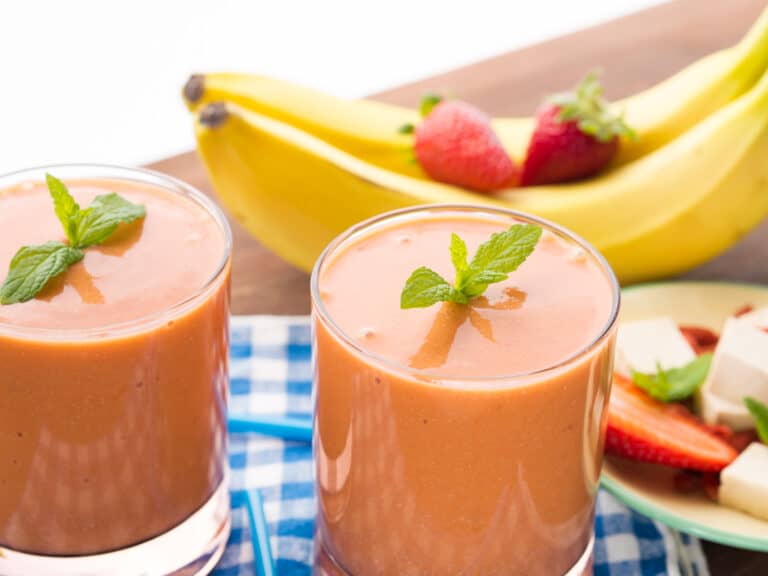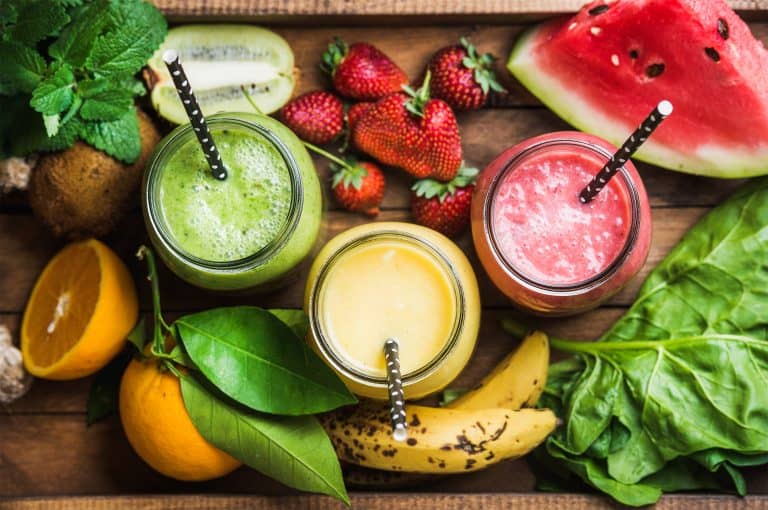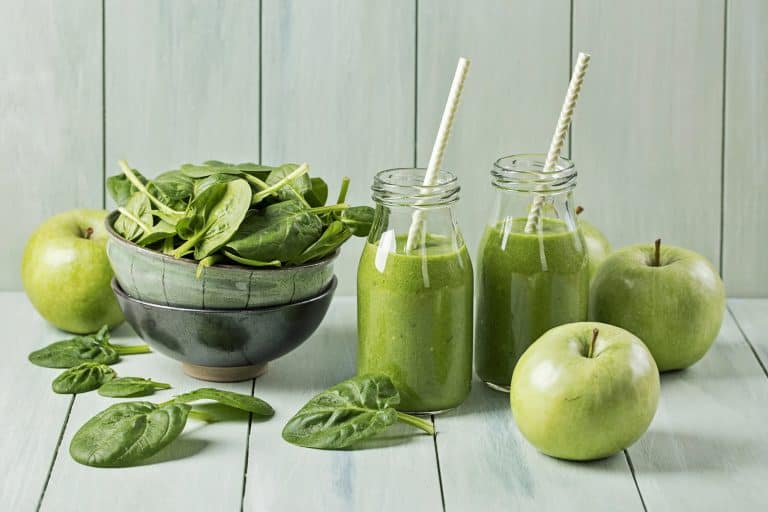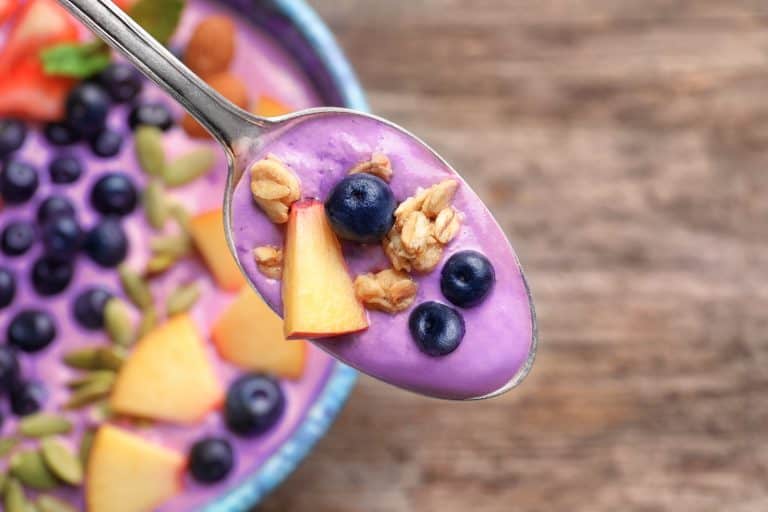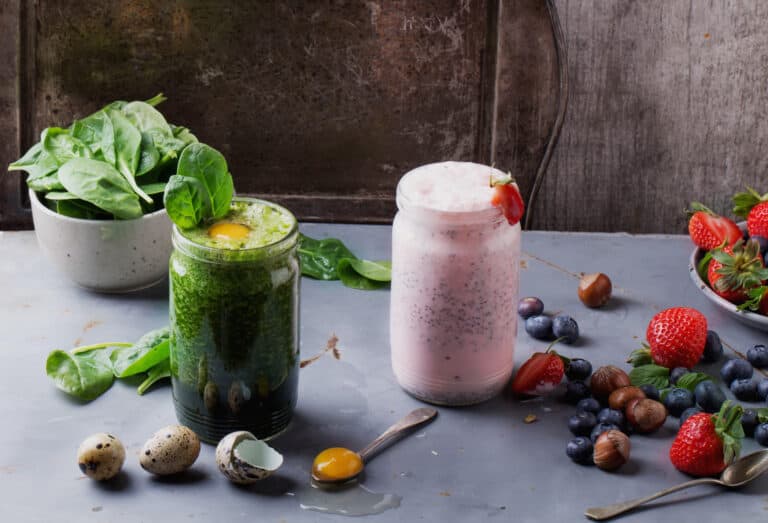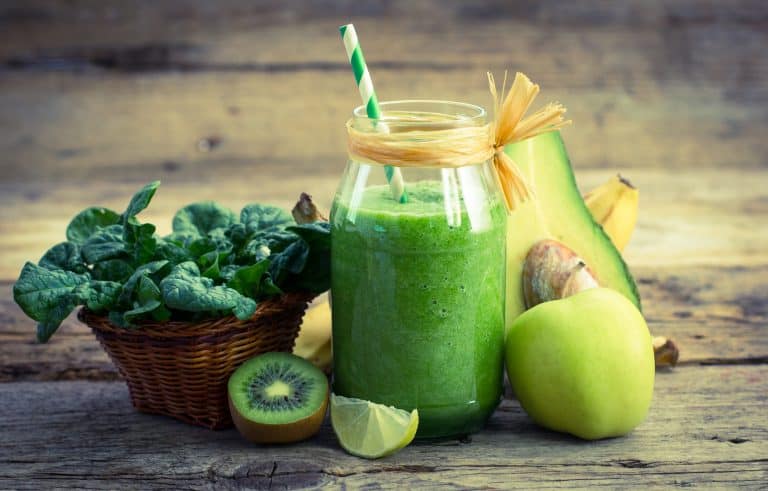How to Use Aloe Vera in Smoothies
Disclosure: This post may contain affiliate links, meaning I get a commission if you decide to make a purchase through my links, at no cost to you.
Aloe vera has long been known for its numerous health benefits and its versatility in skincare and health products, but have you ever wondered how to use aloe vera in smoothies?
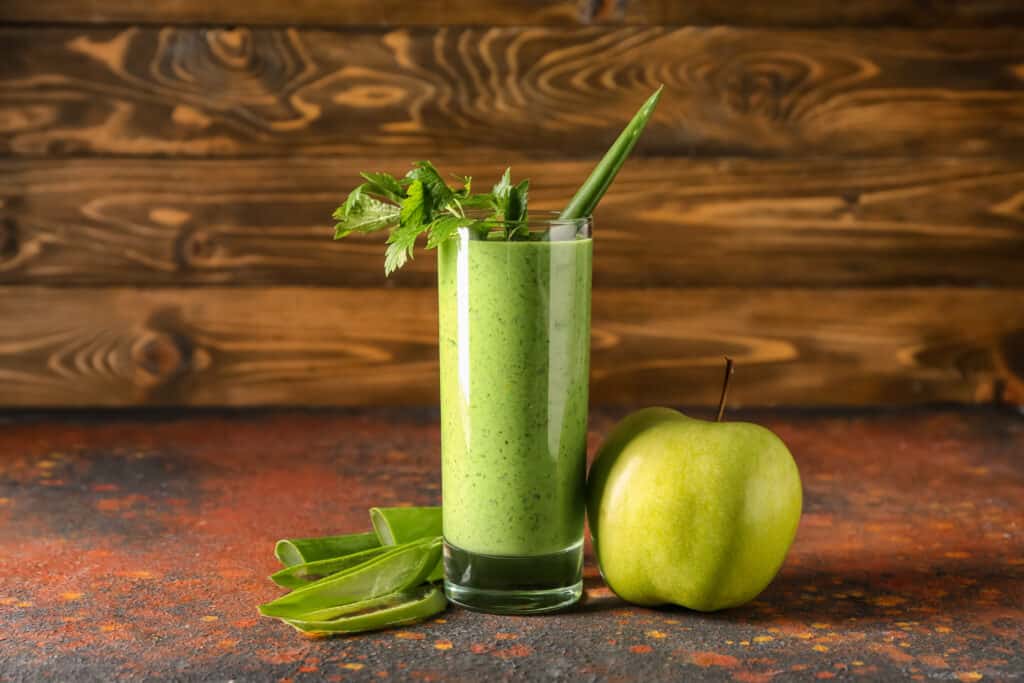
Incorporating aloe vera in your daily diet can provide an array of benefits, from supporting digestive health to boosting immune function. Smoothies are an easy and delicious way to enjoy the goodness of aloe vera, and this blog post is here to guide you through the process.
In this article, we will explore the health benefits of aloe vera, from its antioxidant properties to its anti-inflammatory and antimicrobial properties. We’ll also discuss how to choose and prepare fresh aloe leaves or aloe vera gel, as well as provide some scrumptious aloe vera smoothie recipes.
Whether you’re looking to improve skin health, manage blood sugar levels, or simply enjoy a refreshing treat, incorporating aloe vera into your smoothies is a tasty and nutritious choice.
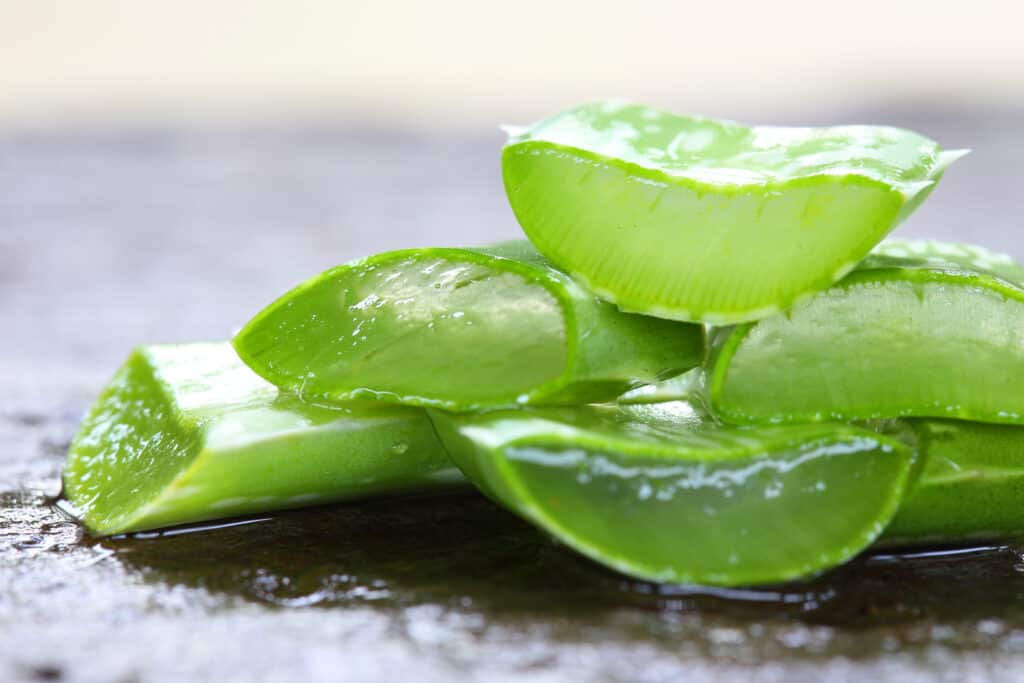
Health Benefits of Aloe Vera
Nutrient Profile: Vitamins, Minerals, and Enzymes
Aloe vera is a rich source of vitamins and minerals, including vitamins A, C, E, B12, folic acid, and essential minerals such as calcium, magnesium, and zinc. These nutrients play a vital role in maintaining overall health, including immune function, skin health, and blood sugar control.
Digestive Health Support
Aloe vera has long been used as a natural remedy for digestive issues, such as stomach cramps and constipation. Its healing properties can help soothe the stomach lining and alleviate stomach acid, promoting a healthy digestive tract. Additionally, aloe vera has been found to aid in the absorption of nutrients, further enhancing the benefits of your smoothies.
Immune System Support
The antioxidants in aloe vera help strengthen the immune system by combating free radicals and reducing chronic inflammation. A balanced diet that includes aloe vera can provide the necessary support for immune function and overall well-being.
Anti-inflammatory Properties
Aloe vera contains compounds with powerful anti-inflammatory properties, which can help alleviate symptoms of chronic inflammation, such as pain and swelling. These benefits make aloe vera an excellent addition to smoothies for individuals looking to manage inflammatory conditions or support their weight loss goals.
Skin Health Benefits
Aloe vera has been widely used to treat various skin conditions, including acne, eczema, and sunburns, thanks to its soothing and hydrating properties. Regular consumption of aloe vera can promote skin hydration and overall skin health, making it a valuable addition to your daily basis smoothie routine.
Learn more about the health benefits of aloe here.
Choosing the Right Aloe Vera for Smoothies
Fresh Aloe Vera Leaves vs. Store-Bought Aloe Products
Benefits of Using Fresh Aloe Leaves
Using fresh aloe leaves in your smoothies offers the advantage of getting the most nutrients and bioactive compounds directly from the source. Fresh aloe vera gel is not only more potent but also free from preservatives and additives, ensuring a clean taste and higher nutritional value.
Comparing Fresh Aloe Vera Gel and Aloe Juice
While fresh aloe vera gel is extracted directly from the plant’s leaves, aloe juice is often derived from the whole leaf and can contain additional water content. For smoothies, fresh aloe vera gel is the preferred option, as it provides a creamier texture and a higher concentration of nutrients.
How to Choose and Store Fresh Aloe Vera Leaves
Selecting the Right Aloe Species
Not all aloe species are suitable for consumption. Aloe barbadensis miller, commonly known as aloe vera, is the most widely used species for its health benefits. When choosing fresh aloe leaves, ensure you select the correct species to avoid any potential adverse effects.
Identifying Healthy, Fleshy Leaves
Healthy aloe vera leaves are thick, fleshy, and green, with no visible signs of damage or wilting. Choose leaves that are at least 12 inches long, as they are more likely to contain a higher concentration of the beneficial gel.
Proper Storage Techniques for Fresh Leaves
To maintain freshness, store aloe vera leaves in a cool, dark place, such as a pantry or cupboard. If you need to store them for an extended period, wrap the leaves in a damp cloth and place them in a sealed plastic bag in the refrigerator.
How to Choose High-Quality Store-Bought Aloe Vera Products
Assessing the Quality of Aloe Vera Gel
When choosing store-bought aloe vera gel, opt for products that are as close to 100% pure aloe as possible. Check the label for additives, such as artificial colors or fragrances, and avoid products with a long list of ingredients. Look for trusted brands and consider shopping at health food stores that prioritize quality.
Evaluating Aloe Juice Options
If you decide to use aloe juice in your smoothies, choose options that are made from the inner leaf gel rather than the whole leaf, as this provides a purer and more nutrient-dense product. Avoid aloe juice with added sugars or artificial flavors, as these can diminish the health benefits.
Precautions and Safety Measures when Using Aloe Vera
Avoiding Aloe Products with Additives or Preservatives
Additives and preservatives can compromise the quality and benefits of aloe vera. Always choose products that are free of artificial ingredients to ensure you are getting the most from your aloe vera smoothie.
Recognizing Potential Allergens and Side Effects
Some individuals may experience an allergic reaction or sensitivity to aloe vera. If you are new to consuming aloe vera, start with a small amount and monitor your body’s response. If you experience any adverse reactions, such as stomach cramps or skin irritation, discontinue use and consult a healthcare professional.
Understanding the Appropriate Consumption Levels for Aloe Vera
While aloe vera offers numerous health benefits, consuming it in excessive amounts can lead to an electrolyte imbalance or digestive issues. Stick to the recommended serving size in smoothie recipes and consult a healthcare professional if you have concerns about incorporating aloe vera into your diet.
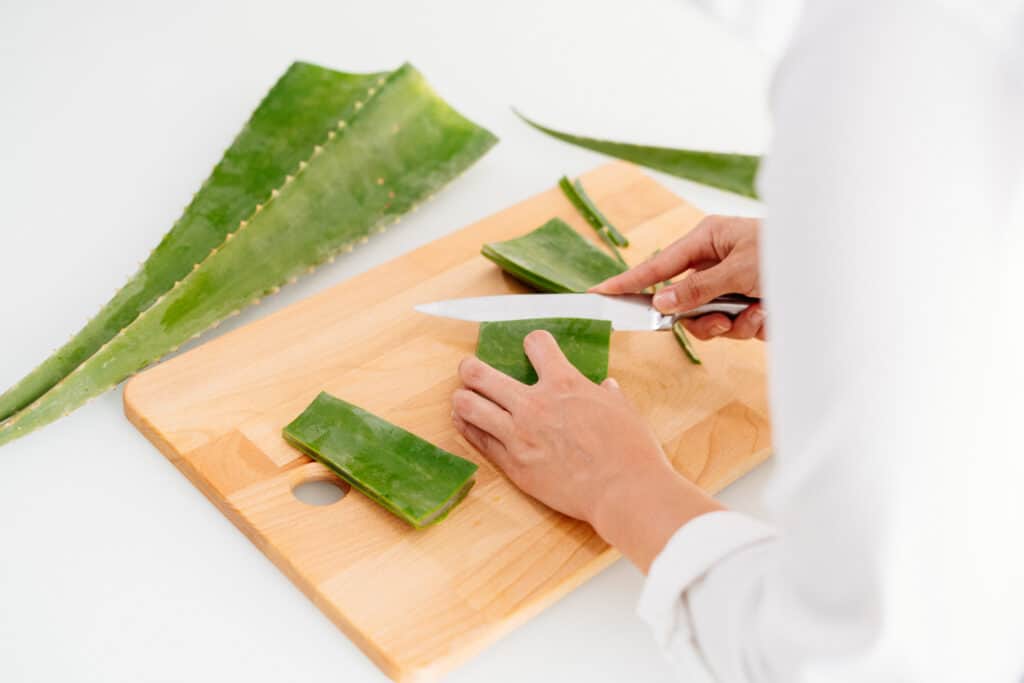
Preparing Aloe Vera for Smoothies
How to Extract Aloe Vera Gel from Fresh Leaves
Tools and Materials Needed
To extract fresh aloe vera gel, you will need a cutting board, a sharp knife, and a clean container or mason jar to store the gel.
Step-by-Step Process
- Wash the fresh aloe leaf thoroughly under running water to remove any dirt or debris.
- Place the leaf on a cutting board and trim off the spiky edges on both sides using a sharp knife.
- Cut off the bottom of the leaf to remove the yellow sap, known as latex, which can cause stomach irritation.
- Slice the leaf lengthwise into two halves.
- Using a spoon or the edge of the knife, carefully scoop out the clear aloe gel from the leaf, avoiding the green outer layer.
- Place the extracted gel in a clean container or mason jar and store it in the refrigerator until ready to use.
How to Store Aloe Vera Gel for Future Use
Fresh aloe vera gel can be stored in the refrigerator for up to two weeks. To extend its shelf life, you can freeze the gel in ice cube trays and transfer the frozen cubes to a sealed plastic bag. Frozen aloe vera gel can be stored for several months and used directly in smoothies as needed.
Tips for Using Store-Bought Aloe Vera Gel
When using store-bought aloe vera gel, ensure it is free from additives or preservatives. Measure the recommended amount of gel according to the smoothie recipe and mix it well with the other ingredients to achieve a smooth and creamy texture. Store the remaining aloe vera gel in the refrigerator according to the product’s instructions.
Aloe Vera Smoothie Recipes
Basic Aloe Vera Smoothie Recipe
- 1/4 cup fresh aloe vera gel or 2 tablespoons of aloe juice
- 1 cup coconut water or coconut milk
- 1 cup mixed frozen berries (blueberries, raspberries, and strawberries)
- 1 small banana
- 1 tablespoon honey or agave nectar (optional)
Blend all ingredients in a blender until smooth and creamy. Adjust sweetness with honey or agave nectar, if desired. Serve immediately.
Aloe Vera and Green Vegetable Smoothie
- 2 ounces of fresh aloe vera gel or 1/4 cup aloe juice
- 1 cup fresh spinach or kale
- 1/2 cup diced cucumber
- 1/2 green apple, cored and chopped
- 1/2 avocado
- 1 cup water or coconut water
- 1 tablespoon fresh ginger, grated (optional)
Blend all ingredients in a blender until smooth. Serve immediately for a refreshing and nutrient-dense drink.
Aloe Vera and Fruit Smoothie
- 1 tablespoon of fresh aloe vera gel or 2 tablespoons aloe juice
- 1/2 cup orange juice
- 1/2 cup diced pineapple
- 1/2 cup fresh strawberry or frozen strawberries
- 1 small banana
- 1/2 cup plain yogurt or non-dairy alternative
Blend all ingredients in a blender until smooth. Enjoy this tropical fruit smoothie as a refreshing treat.
Aloe Vera, Nut Butter, and Protein Powder Smoothie
- 2 tablespoons fresh aloe vera gel or 1 tablespoon aloe juice
- 1 cup almond milk or another milk alternative
- 1 scoop protein powder (vanilla or chocolate)
- 1 tablespoon almond butter or peanut butter
- 1 small banana
- 1/2 cup ice
Blend all ingredients in a blender until smooth and creamy. This protein-packed smoothie is perfect for post-workout or strength training sessions.
Aloe Vera and Tropical Fruit Smoothie
- 1/4 cup fresh aloe vera gel or 2 tablespoons aloe juice
- 1 cup coconut milk
- 1/2 cup diced pineapple
- 1/2 cup diced mango
- 1 small banana
- 1/2 cup ice
Blend all ingredients in a blender until smooth and creamy. This tropical smoothie is perfect for a delicious and healthy breakfast or snack.
Customizing Aloe Vera Smoothies
- Add natural sugars: If you prefer a sweeter smoothie, consider adding natural sugars, such as honey, agave nectar, or dates, to taste. These natural sweeteners can enhance the flavor without causing a significant spike in blood sugar levels.
- Boost electrolytes with coconut water: Replace water or milk alternatives with coconut water to increase the electrolyte content of your smoothie. This can be especially beneficial for those who engage in intense physical activity or are prone to dehydration.
- Incorporate healthy fats: Adding a source of healthy fats, such as avocado, nut butter, or chia seeds, can make your smoothie more filling and provide additional health benefits, such as improved heart health and reduced inflammation.
- Increase fiber: To support digestive health, consider adding a high-fiber ingredient, such as ground flaxseed, chia seeds, or oats, to your aloe vera smoothie.
- Enhance protein content: For a more satisfying and balanced smoothie, add a scoop of your favorite protein powder, Greek yogurt, or a nut butter to increase the protein content.
- Add superfoods: Boost the nutritional profile of your aloe vera smoothie by incorporating superfoods, such as spirulina, wheatgrass, or goji berries.
- Vary the fruits: Experiment with different fruits, such as kiwi, papaya, or pomegranate, to create unique flavor combinations and add variety to your daily diet.
- Incorporate herbs and spices: Enhance the flavor and health benefits of your aloe vera smoothie by adding herbs and spices, such as fresh mint, basil, cinnamon, or ginger.
- Adjust the texture: Modify the consistency of your smoothie by adding more or less liquid or adjusting the ratio of ice or frozen ingredients. For a thicker, more dessert-like treat, use less liquid and more frozen fruit, while for a lighter, more refreshing drink, increase the liquid content.
- Opt for weight loss-friendly ingredients: If you’re aiming to lose weight, choose low-calorie, nutrient-dense ingredients for your aloe vera smoothie. Opt for water or unsweetened milk alternatives, and incorporate plenty of leafy greens and low-sugar fruits, such as berries or green apples.
Common Questions About How to Use Aloe Vera in Smoothies
A general recommendation is to add 1/4 cup of fresh aloe vera gel or 1-2 tablespoons of aloe juice to your smoothie. However, you can adjust the amount according to your taste and individual health needs. Consult a healthcare professional if you have concerns about incorporating aloe vera into your daily diet.
Yes, you can add raw aloe vera to your smoothie. It is recommended to use the clear gel extracted from fresh aloe leaves, as it contains the most nutrients and bioactive compounds. Be sure to properly prepare the aloe vera by removing the green outer layer and yellow latex to avoid potential digestive issues or stomach irritation.
Aloe vera can be a great addition to smoothies for weight loss due to its low calorie content and potential to support digestive health. When creating a weight loss-friendly aloe vera smoothie, choose low-calorie, nutrient-dense ingredients, such as leafy greens, low-sugar fruits, and unsweetened milk alternatives.
Aloe vera is generally considered safe for daily consumption when used in moderate amounts. However, excessive consumption of aloe vera can lead to potential side effects, such as electrolyte imbalance or digestive issues. Consult a healthcare professional if you have concerns about incorporating aloe vera into your daily diet.
Yes, store-bought aloe vera products, such as aloe vera gel or aloe juice, can be used in smoothies. Ensure the product is free from additives or preservatives and is as close to 100% pure aloe as possible. Check the label for quality indicators and consider purchasing from health food stores or trusted brands.
Final Thoughts on How to Use Aloe Vera in Smoothies
Aloe vera offers a wealth of health benefits, making it an excellent addition to your smoothie repertoire. By incorporating aloe vera in various forms, such as fresh aloe vera gel, aloe juice, or store-bought aloe products, you can create delicious and nutrient-dense smoothies tailored to your individual taste and health needs.
Experiment with different fruits, vegetables, and additional ingredients to create unique flavor combinations and fully harness the potential of aloe vera in your daily diet. Whether you’re seeking to improve your skin health, support digestion, or simply enjoy a refreshing and healthy drink, aloe vera smoothies are a versatile and beneficial option for everyone.
Happy Blending!
Amanda
